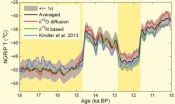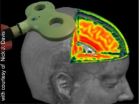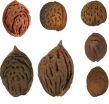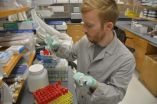(Press-News.org) Antibiotic stewardship programs, which promote the appropriate use of antibiotics in hospitals and other healthcare centers, not only lead to reduction in antibiotic use with reduced adverse events, but also lead to significant savings. In the case of one New York hospital, more than $600,000 was saved annually, according to research presented today at the 54th Interscience Conference on Antimicrobial Agents and Chemotherapy (ICAAC), an infectious diseases meeting of the American Society for Microbiology (ASM).
"This work emphasizes the rational approach to treating patients: choosing antibiotics at correct doses only when really needed, limiting side-effects, limiting the selection of super bugs, and limiting the risk of infection to new patients admitted to hospitals," says Nishant Prasad, M.D., attending physician, The Dr. James J. Rahal, Jr. Division of Infectious Diseases, New York Hospital Queens.
Dr. Prasad and his colleagues tracked the rate of antibiotic-resistant infections, antibiotic use patterns, and antibiotic-related costs after the implementation of a hospital-wide antibiotic stewardship program at New York Hospital Queens, a 535-bed community hospital in Flushing, New York. At least half of the more than 5,000 interventions made by the program in 2013 improved patient safety and led to more than $600,000 in antibiotic-related savings. Additionally, they found the rate of antibiotic-resistant infections decreased including methicillin-resistant Staphylococcus aureus (MRSA), multidrug-resistant Acinetobacter baumannii, Klebsiella pneumoniae, and hospital-acquired Clostridium difficile- associated diarrhea.
"With our antibiotic stewardship program, we demonstrated decreased antibiotic use and increased antibiotic-related cost savings, as well as a significant decrease in antibiotic-resistant infections. We believe these findings show that limiting unnecessary antibiotics improves patient safety and streamlines use of limited healthcare dollars," says Dr. Prasad.
Other research presented at the meeting also shows the results of antibiotic stewardship programs. A study carried out by researchers at Skåne University Hospital in Malmö, Sweden during a six-month period at four geriatric wards found a 27% decrease in antibiotic use when guided by a brief discussion with an infectious disease specialist. The reduction did not affect mortality, but a reduction in hospital readmissions due to infection was observed.
"The strategy seems to be a cost-effective, promising way to reduce antibiotic use with very little risk to the individual patient," says Fredrik Resman, Skåne University Hospital, who presented the data. "The success of this very simple strategy has led to a continuation on a permanent basis."
Antibiotics have transformed the practice of medicine, making once lethal infections readily treatable and making other medical advances, like cancer chemotherapy and organ transplants, possible. The prompt initiation of antibiotics to treat infections has been proven to reduce morbidity and save lives. The U.S. Centers for Disease Control and Prevention (CDC) estimates that 20%-50% of all antibiotics prescribed in U.S. acute care hospitals are either unnecessary or inappropriate. A growing body of evidence suggests that antibiotic stewardship programs can both optimize treatment of infections and reduce the incidence of adverse events associated with antibiotic use. In recognition of the urgent need to improve antibiotic use in hospitals and the benefits of antibiotic stewardship programs, in 2014 CDC recommended that all acute care hospitals implement Antibiotic Stewardship Programs.
INFORMATION:
This research was presented as part of the ASM's 54th ICAAC held September 5-9, 2014 in Washington, DC. A full press kit for the meeting, including tipsheets and additional press releases, can be found online at http://bit.ly/54icaacpk.
The American Society for Microbiology is the largest single life science society, composed of over 39,000 scientists and health professionals. ASM's mission is to advance the microbiological sciences as a vehicle for understanding life processes and to apply and communicate this knowledge for the improvement of health and environmental and economic well-being worldwide.
Antibiotic stewardship programs reduce costs, improve outcomes
2014-09-06
ELSE PRESS RELEASES FROM THIS DATE:
New study reveals strong link between higher levels of pollution and lung health of European citizen
2014-09-06
New data has identified a clear link between higher levels of exposure to air pollution and deteriorating lung health in adult European citizens. This study confirms previous findings that children growing up in areas with higher levels of pollution will have lower levels of lung function and a higher risk of developing symptoms such as cough and bronchitis symptoms. Additionally, the new study identified that people suffering from obesity are particularly vulnerable to the negative effects of air pollution, possibly due to an increased risk of lung inflammation.
Senior ...
Penn team finds ovarian cancer oncogene in 'junk DNA'
2014-09-06
PHILADELPHIA - Over the years researchers have made tremendous strides in the understanding and treatment of cancer by searching genomes for links between genetic alterations and disease.
Most of those studies have focused on the portion of the human genome that encodes protein – a fraction that accounts for just 2 percent of human DNA overall. Yet the vast majority of genomic alterations associated with cancer lie outside protein-coding genes, in what traditionally has been derided as "junk DNA." Researchers today know that "junk DNA" is anything but – much of it is ...
Past temperature in Greenland adjusted
2014-09-05
One of the common perceptions about the climate is that the amount of carbon dioxide in the atmosphere, solar radiation and temperature follow each other – the more solar radiation and the more carbon dioxide, the hotter the temperature. This correlation is also seen in the Greenland ice cores that are drilled through the approximately three kilometer thick ice sheet. But during a period of several thousand years up until the last ice age ended approximately 12,000 years ago, this pattern did not fit and this was a mystery to researchers. Now researchers from the Niels ...
WHO-commissioned report on e-cigarettes misleading, say experts
2014-09-05
World leading tobacco experts argue that a recently published World Health Organization (WHO)-commissioned review of evidence on e-cigarettes contains important errors, misinterpretations and misrepresentations putting policy-makers and the public in danger of foregoing the potential public health benefits of e-cigarettes.
The authors, writing today in the journal Addiction, analyse the WHO-commissioned Background Paper on E-cigarettes, which looks to have been influential in the recently published WHO report calling for greater regulation of e-cigarettes.
Professor ...
Visualizing plastic changes to the brain
2014-09-05
Tinnitus, migraine, epilepsy, depression, schizophrenia, Alzheimer's: all these are examples of diseases with neurological causes, the treatment and study of which is more and more frequently being carried out by means of magnetic stimulation of the brain. However, the method's precise mechanisms of action have not, as yet, been fully understood. The work group headed by PD Dr Dirk Jancke from the Institut für Neuroinformatik was the first to succeed in illustrating the neuronal effects of this treatment method with high-res images.
Painless Therapy
Transcranial magnetic ...
Harvard and Cornell researchers develop untethered, autonomous soft robot
2014-09-05
New Rochelle, NY, September 4, 2014--Imagine a non-rigid, shape-changing robot that walks on four "legs," can operate without the constraints of a tether, and can function in a snowstorm, move through puddles of water, and even withstand limited exposure to flames. Harvard advanced materials chemist George Whitesides, PhD and colleagues describe the mobile, autonomous robot they have created in Soft Robotics, a peer-reviewed journal from Mary Ann Liebert, Inc., publishers. The article is available on the Soft Robotics website.
In "A Resilient, Untethered Soft Robot," ...
Study: Viral infection in nose can trigger middle ear infection
2014-09-05
WINSTON-SALEM, N.C. – Sept. 5, 2014 – Middle ear infections, which affect more than 85 percent of children under the age of 3, can be triggered by a viral infection in the nose rather than solely by a bacterial infection, according to researchers at Wake Forest Baptist Medical Center.
By simultaneously infecting the nose with a flu virus and a bacterium that is one of the leading causes of ear infections in children, the researchers found that the flu virus inflamed the nasal tissue and significantly increased both the number of bacteria and their propensity to travel ...
NASA adds up heavy rainfall from Hurricane Norbert
2014-09-05
As Hurricane Norbert continued dropping heavy amounts of rainfall on Mexico's Baja California on September 5, NASA's TRMM satellite calculated the rain that had already fallen.
From its orbit in space, the Tropical Rainfall Measuring Mission or TRMM satellite has the capability of determining how much rainfall has occurred over given areas. Data from TRMM was compiled into a rainfall map that showed the rainfall generated from Tropical Storm Dolly and Hurricane Norbert from August 28 through September 4, 2014.
Tropical storm Dolly dissipated quickly after coming ashore ...
It's the pits: Ancient peach stones offer clues to fruit's origins
2014-09-05
Anyone who enjoys biting into a sweet, fleshy peach can now give thanks to the people who first began domesticating this fruit: Chinese farmers who lived 7,500 years ago.
In a study published today in PLOS ONE, Gary Crawford, a U of T Mississauga anthropology professor, and two Chinese colleagues propose that the domestic peaches enjoyed worldwide today can trace their ancestry back at least 7,500 years ago to the lower Yangtze River Valley in Southern China, not far from Shanghai. The study, headed by Yunfei Zheng from the Zhejiang Institute of Archeology in China's ...
Like weeds of the sea, 'brown tide' algae exploit nutrient-rich coastlines
2014-09-05
The sea-grass beds of Long Island's Great South Bay once teemed with shellfish. Clams, scallops and oysters filtered nutrients from the water and flushed money through the local economy. But three decades after the algae that cause brown tides first appeared here, much of the sea grass and the bounty it used to provide is gone.
Spring on eastern Long Island is now marked by dense blooms of Aureococcus anophagefferens, which turn estuaries like Great South Bay the color of mud and crowd out native sea grass and stunt or poison shellfish. For years, researchers have puzzled ...






